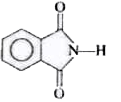Which of the following compounds can form a Zwitter ion ?
Benzoic acid
Acetanilide
Aniline
Glycine
The correct Answer is:D
To determine which of the given compounds can form a zwitterion, we need to understand what a zwitterion is. A zwitterion is a molecule that has both positive and negative charges but is overall electrically neutral. This typically occurs in amino acids at their isoelectric point, where the amino group is protonated (NH3+) and the carboxyl group is deprotonated (COO-).
Let's analyze each option step by step:
Step 1: Analyze Benzoic Acid
- Structure: Benzoic acid has the formula C6H5COOH.
- Functional Groups: It contains a carboxylic acid group (-COOH).
- Charge Formation: At neutral pH, benzoic acid can lose a proton from the carboxylic acid group, forming the benzoate ion (C6H5COO-), but it does not have a basic amine group to gain a proton and form a positive charge.
- Conclusion: Benzoic acid cannot form a zwitterion.
Step 2: Analyze Acetanilide
- Structure: Acetanilide has the formula C6H5NH(CO)CH3.
- Functional Groups: It contains an amide group and a benzene ring.
- Charge Formation: There is no carboxylic acid group to lose a proton, and the nitrogen does not have a proton to donate to form a positive charge.
- Conclusion: Acetanilide cannot form a zwitterion.
Step 3: Analyze Aniline
- Structure: Aniline has the formula C6H5NH2.
- Functional Groups: It contains an amine group (-NH2) attached to a benzene ring.
- Charge Formation: Aniline can accept a proton to become anilinium (C6H5NH3+), but it does not have a carboxylic acid group to lose a proton and form a negative charge.
- Conclusion: Aniline cannot form a zwitterion.
Step 4: Analyze Glycine
- Structure: Glycine has the formula NH2CH2COOH.
- Functional Groups: It contains both an amino group (-NH2) and a carboxylic acid group (-COOH).
- Charge Formation: At the isoelectric point, glycine can exist as NH3+ (protonated amine) and COO- (deprotonated carboxylic acid), resulting in a zwitterion.
- Conclusion: Glycine can form a zwitterion.
Final Answer
The compound that can form a zwitterion is D) Glycine.
- Structure: Benzoic acid has the formula C6H5COOH.
- Functional Groups: It contains a carboxylic acid group (-COOH).
- Charge Formation: At neutral pH, benzoic acid can lose a proton from the carboxylic acid group, forming the benzoate ion (C6H5COO-), but it does not have a basic amine group to gain a proton and form a positive charge.
- Conclusion: Benzoic acid cannot form a zwitterion.
- Structure: Acetanilide has the formula C6H5NH(CO)CH3.
- Functional Groups: It contains an amide group and a benzene ring.
- Charge Formation: There is no carboxylic acid group to lose a proton, and the nitrogen does not have a proton to donate to form a positive charge.
- Conclusion: Acetanilide cannot form a zwitterion.
- Structure: Aniline has the formula C6H5NH2.
- Functional Groups: It contains an amine group (-NH2) attached to a benzene ring.
- Charge Formation: Aniline can accept a proton to become anilinium (C6H5NH3+), but it does not have a carboxylic acid group to lose a proton and form a negative charge.
- Conclusion: Aniline cannot form a zwitterion.
- Structure: Glycine has the formula NH2CH2COOH.
- Functional Groups: It contains both an amino group (-NH2) and a carboxylic acid group (-COOH).
- Charge Formation: At the isoelectric point, glycine can exist as NH3+ (protonated amine) and COO- (deprotonated carboxylic acid), resulting in a zwitterion.
- Conclusion: Glycine can form a zwitterion.
The compound that can form a zwitterion is D) Glycine.
Similar Questions
Knowledge Check
Which of the following compounds will form alcohol with NaNO2/HCl ?
A B
B CCH3−CH2−NH2DAll of these
CCH3−CH2−NH2DAll of theseWhich of the following compounds can react with base to form salt?
A B
B C
C D
D
Which of the following compound are meso forms?
 A1 onlyB3 onlyC1 and 2D2 and 3
A1 onlyB3 onlyC1 and 2D2 and 3
Which of the following compounds can form H-bonding with each other ?
View SolutionWhich of the following compounds can form H-bonding with each other ?
View SolutionCyanodydrin of which of the following compound can form lactic acid ?
View SolutionWhich of the following compound can form during the free radical chlorination of methane?
View SolutionWhich of the following compound are meso forms?

View Solution
